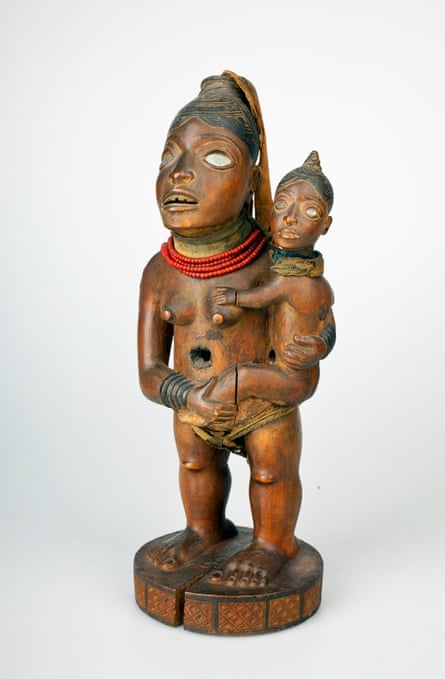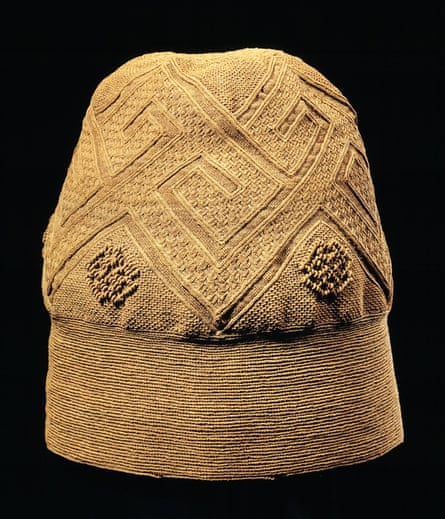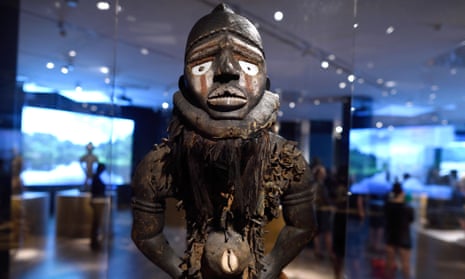They glower at you, little human that you are: fearsome, glorious spirits, more than a dozen of them, throbbing with electric power. Their heads jut forth and their torsos are thrust forward, asserting their dominance and incontrovertibility. And if that weren’t enough, they are armed – their chests studded with innumerable nails and blades, a metallic proof of authority. They are literally awe-inspiring.
The 15 Mangaaka power figures (three-quarters of the world’s surviving examples) at the heart of Kongo: Power and Majesty, a landmark exhibition that opens on Friday at the Metropolitan Museum of New York, are a high point in the history of art. But they arose from one of the darkest places in African history: the unspeakably horrific Belgian colonial enterprise, whose leaders engaged in a systematic campaign of exploitation, torture and murder rightly compared to the Holocaust. The power figures, initially meant to incarnate law and order in Kongo communities, became defense mechanisms for a people facing a terrifying onslaught. The colonists knew as much, and seized them – destroying most, and locking the rest in the dull spaces of their ethnographic museums.

On their own, the Mangaaka display would be a show worth seeing. Kongo: Power and Majesty, organized by Met curator Alisa Lagamma, is much more ambitious than that. This rigorous and unshowily erudite exhibition looks at Kongo civilisation – from a region that encompasses contemporary Democratic Republic of Congo, Congo Republic and Angola – across five centuries, with a particular focus on international connections and exchanges. It meticulously places the ivories, textiles, masks and statues in historical context, decade by decade, and unwinds any enduring “primitivist” stereotypes that still attend African art. It is that rarest thing: a scholarly blockbuster. (It also forms a nice counterpart to Picasso Sculpture, the blowout across town at the Museum of Modern Art. Picasso’s great Cubist breakthrough came about after months looking at African sculpture – though he was more into west African than central African art.)
It opens, in the late 15th century, with a shrewd juxtaposition. A limestone column, incised with barely legible Portuguese, states that the king in Lisbon “ordered this land to be discovered”. But “this land” was already a kingdom. Across from the column is an oliphant: a horn made of ivory, whose extraordinary carved surface features spiraling and interlocking squiggles. By the beginning of the 16th century, it was in the collection of Pope Leo X.

From the start, then, this is a show about contact. By extension, it’s a show about collecting. In the 17th century, Kongo decorative arts were highly prized by western aesthetes, who displayed textiles, ivories and other nonrepresentational objects in Wunderkammern, or cabinets of curiosities. (Almost everything that survives of Kongo material culture before the colonial period comes from these collections.) Intricate raffia cushion cases, decorated with interlocking diamonds and chevrons, made their way to cosmopolitan collections from Florence to Stockholm. One inventory from 1650 attests that a Kongo textile was valued nearly as highly as European landscape paintings.
At the same time, Kongo leaders were in dialogue with European counterparts, and Kongo officials came north. A letter here from 1514, from Kongo king Afonso I to Manuel I of Portugal, constitutes an invaluable African primary source on the changing landscape of central Africa. (The elite’s early adoption of written language and of Christianity, and the recording of centuries of oral history in Kikongo, means Kongo’s past is much better attested than that of other African civilisations.) One amazing etching from 1608 depicts the Kongo ambassador Antonio Manuel, given a European-style title of marquess, borne on a litter towards the Vatican. He died in Rome, and his body was processed through the streets to Santa Maria Maggiore, where he received last rites from the pope himself.
In Kongo societies, power was legitimated through the approbation of the spirit realm – one in which Christian and pre-Christian divinities easily coexisted – and manifest not just through material wealth, but through human relationships. The phrase mbongo bantu, “treasure in people”, captures the dynamic: wives, children, slaves and trading partners were a form of human capital, more valuable than any luxury.

You still need a nice outfit though, and two kinds of regalia were especially important to Kongo leaders. One was the mpu, a cap made out of raffia fibre worn by chiefs and elders. If you were an especially big shot, you might have an mpu adorned with leopard claws: one example here has more than a dozen. The other was the sceptre, topped in the most opulent cases with a carved ivory finial. These finials could take the form of women and babies, of Christian saints, of chiefs seated with dogs. Of slaves, too. One ivory here features a chief gnawing on a witchcraft-repelling root, while a wretched prisoner is tied up beneath him.
The decimation of Kongo societies begins with the intercontinental slave trade, and a few objects here hint at its brutalities. An ivory tusk has a figurative relief spiraling up its surface, on which we see men with rope around their necks being hauled to Brazil or the Caribbean, or maybe being strangled. More than a third of society is taken to the New World, and with the rise of colonialism, it gets even worse back home. You have to look in the gaps and interstices of Kongo art to see the hideous, unforgivable inhumanity of King Leopold’s enterprise. Figures of women breast-feeding children, Lagamma notes, become especially prevalent as the slave trade and colonial forces drain these societies. Kongo, after all, was a place where human relationships were everything. These statues of nursing women, many of them with skin cicatrized with diamonds or spirals, are delicate entreaties for new life.

And then there are the Mangaaka, the power figures, dramatically staged in a single gallery. Unfathomably commanding works of art, they were nothing less than the embodiment of social authority, and were credited with the power to heal supplicants and afflict wrongdoers. Each nail or blade in the wooden surface is evidence of a social contract that the power figure would adjudicate: a divorce, a land dispute, or a trade deal would be ratified in the presence of the Mangaaka, and made binding with the nail hammered in. Their artistic sophistication testifies to their importance in Kongo society, but we now know that the power figures were cared for by medical specialists, known as nganga, who anointed the statues’ eyes and stomachs. When the Europeans took them, the nganga deconsecrated them – removing the innards, and applying new paint to the faces in a last act of sabotage.
For this formidable show the Met has secured loans from no fewer than 50 museums and private collections. The Mangaaka alone have traveled from Rotterdam, Stockholm, Paris, Stuttgart and Liverpool, while other masterpieces have come from arts institutions and ethnographic museums from all over the US and Europe. There is nothing, though, from a collection in Brazzaville or Kinshasa. It’s only right that an exhibition charting 500 years of Kongo history should expose our own museums’ complicity in the scramble for Africa, and the deportation of not only African people but African things. We can’t unwind the collections, any more than we can undo the slave trade or colonialism. But when curators and scholars recount history with the rigour and conviction seen here, even our western imperial museums can be turned into spaces of justice.
- Kongo: Power and Majesty is at the Metropolitan Museum of Art until 3 January

Comments (…)
Sign in or create your Guardian account to join the discussion